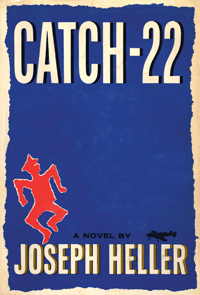With low-cost carriers continuing their inexorable domination of short-haul markets, do network players have no choice but to find a way of working with their low-cost cousins to protect their regional feed flows?
Back in 1961, American author Joseph Heller wrote "Catch-22", coining a term now used to describe no-win situations. In his story, air combat pilots could be grounded by claiming madness. But, as being grounded was the safer option, this demonstrated rational thought. So the request would be rejected and pilots would have to fly - even though it was madness to do so.
It is ironic that this well-known phrase, relating to madness and impossible circular arguments, has its origins in aviation. And in 2010, once again, the industry is winging itself into a circular, seemingly impossible situation.
|
|---|
Catch-22 cover image |
But here's the catch: a successful long-haul network depends on feed from a multitude of sources. One of those is short-haul feed, but if network carriers cannot play in this arena, can they turn to low-cost actors?
This is where the current disconnect is most apparent because the two types of carrier mix as poorly as oil and water. First there is a simple cultural difference, where the nimble David's of the low-cost world sneer at the plodding Goliath's of the networkers. Then there is the very real issue of complexity and its accompanying price tag. Connections, interlining and through-checking baggage involves expensive IT and business process investment.
Another major difficulty is that long-haul flights depend on hub airports for feed from alliance partners and other flights. But hub airports, by their nature, are high-cost and therefore unattractive to the budget carriers.
Each business model has a strength. Each has a weakness. In any other businesses this would be a complementary fit. Not necessarily in aviation. Many long-haul players would kill to have carriers the size of easyJet, Ryanair, AirAsia or Southwest Airlines as their feeder partners. Making this happen and squaring the business case for both sides is a tough one.
There are some trying to bridge this disconnect. Lufthansa and US low-cost partner JetBlue Airways launched codeshare flights in November with travellers transferring between them at New York's JFK airport. Elsewhere, Brazil's Gol ditched its own long-haul flying and now partners with network carriers like Air France and American. This is a one-way deal to keep it simple and cheap with the overseas carriers offering Gol flights to their customers, but not the other way around. When fully running Gol expects a load factor boost of 3.5 points.
Then there are low-cost to low-cost solutions springing up. Malaysian carrier AirAsia set up its own long-haul arm, AirAsia X, which gains a healthy percentage of traffic from its short-haul sister. Other carriers have tried mixed models within their group. In 2009 hybrid carrier Virgin Blue gave birth to long-haul arm V Australia, creating an intra-group feeder operation. V Australia's transpacific flights joined the dots between Virgin Blue and Virgin America's networks.
Progress in bridging the disconnect this year will be made with further tentative steps like these. Many are watching for signs of success or failure and when to copy or fall back. When airline financial health depends on contradictory objectives, it's tough to see the way forward - and claiming madness is not an option or this industry would have been grounded years ago.
In the words of Heller's novel: "That's some catch, that Catch-22."
Source: Airline Business




















